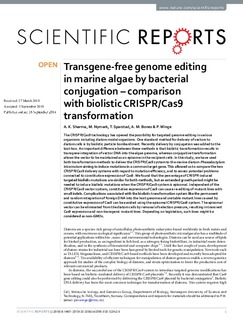| dc.contributor.author | Sharma, Amit Kumar | |
| dc.contributor.author | Nymark, Marianne | |
| dc.contributor.author | Sparstad, Torfinn | |
| dc.contributor.author | Bones, Atle M. | |
| dc.contributor.author | Winge, Per | |
| dc.date.accessioned | 2018-10-03T07:28:09Z | |
| dc.date.available | 2018-10-03T07:28:09Z | |
| dc.date.created | 2018-09-04T15:33:47Z | |
| dc.date.issued | 2018 | |
| dc.identifier.issn | 2045-2322 | |
| dc.identifier.uri | http://hdl.handle.net/11250/2566027 | |
| dc.description.abstract | The CRISPR/Cas9 technology has opened the possibility for targeted genome editing in various organisms including diatom model organisms. One standard method for delivery of vectors to diatom cells is by biolistic particle bombardment. Recently delivery by conjugation was added to the tool-box. An important difference between these methods is that biolistic transformation results in transgene integration of vector DNA into the algae genome, whereas conjugative transformation allows the vector to be maintained as an episome in the recipient cells. In this study, we have used both transformation methods to deliver the CRISPR/Cas9 system to the marine diatom Phaeodactylum tricornutum aiming to induce mutations in a common target gene. This allowed us to compare the two CRISPR/Cas9 delivery systems with regard to mutation efficiency, and to assess potential problems connected to constitutive expression of Cas9. We found that the percentage of CRISPR-induced targeted biallelic mutations are similar for both methods, but an extended growth period might be needed to induce biallelic mutations when the CRISPR/Cas9 system is episomal. Independent of the CRISPR/Cas9 vector system, constitutive expression of Cas9 can cause re-editing of mutant lines with small indels. Complications associated with the biolistic transformation system like the permanent and random integration of foreign DNA into the host genome and unstable mutant lines caused by constitutive expression of Cas9 can be avoided using the episomal CRISPR/Cas9 system. The episomal vector can be eliminated from the diatom cells by removal of selection pressure, resulting in transient Cas9 expression and non-transgenic mutant lines. Depending on legislation, such lines might be considered as non-GMOs. | nb_NO |
| dc.language.iso | eng | nb_NO |
| dc.publisher | Nature Publishing Group | nb_NO |
| dc.rights | Navngivelse 4.0 Internasjonal | * |
| dc.rights.uri | http://creativecommons.org/licenses/by/4.0/deed.no | * |
| dc.title | Transgene-free genome editing in marine algae by bacterial conjugation - comparison with biolistic CRISPR/Cas9 transformation | nb_NO |
| dc.type | Journal article | nb_NO |
| dc.type | Peer reviewed | nb_NO |
| dc.description.version | publishedVersion | nb_NO |
| dc.source.volume | 8 | nb_NO |
| dc.source.journal | Scientific Reports | nb_NO |
| dc.source.issue | 1 | nb_NO |
| dc.identifier.doi | 10.1038/s41598-018-32342-0 | |
| dc.identifier.cristin | 1606686 | |
| dc.relation.project | Norges forskningsråd: 267474 | nb_NO |
| dc.relation.project | Norges forskningsråd: 239001 | nb_NO |
| dc.description.localcode | © The Author(s) 2018. This article is distributed under the terms of the Creative Commons Attribution 4.0 International License (http://creativecommons.org/licenses/by/4.0/) | nb_NO |
| cristin.unitcode | 194,66,10,0 | |
| cristin.unitname | Institutt for biologi | |
| cristin.ispublished | true | |
| cristin.fulltext | original | |
| cristin.qualitycode | 1 | |

